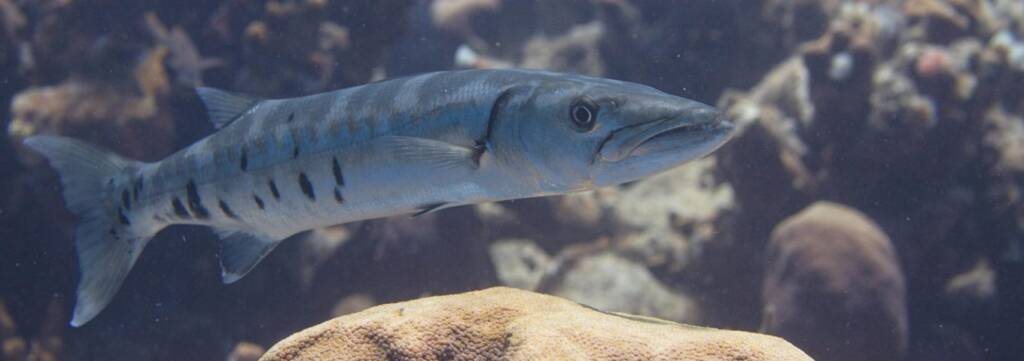
Your Guide to Barracudas in Belize
Oh, barracuda! Some love them; others fear them. It’s true, Barracuda fish have a reputation for being dangerous but they’re not actually as ferocious as they look. Barracudas live in tropical and subtropical oceans around the globe. There are several different species of barracuda. Some of them, including the Great Barracuda, can be found in the waters of Belize. Learn all about these serpent-like fish in this guide to barracudas in Belize.
About Barracudas
Named in 1815, the barracuda, with its fang-like teeth and pointed jaw, spends its time swimming near the top of the water and near coral reefs and seagrasses. Targeted by sports fishing enthusiasts, the barracuda is sometimes referred to as the Tiger of the Sea. The average lifespan of a barracuda is 14 years.
Appearance & Size
Barracudas are normally a variation of dark gray, dark green, white or blue with silvery sides and a white belly. Some species of barracudas grow up to 65 inches (165 cm) in length. Some can grow up to 79 inches – or 2 metres long! Barracudas weigh 10-12 pounds (4.5-5.5 kg), on average, with some species weighing more than others. Usually, it’s the female barracuda that grows bigger than the male.
Diet & Predators
Barracudas are carnivores that eat fish, plankton, and invertebrates. They can swim in quick bursts of speeds up to 27mph (43km/h), which they do to catch their prey. Typically, barracudas hunt for food at night as they’re nocturnal fish. They’re preyed on by sharks, dolphins, killer whales, and humans.
Behaviour
Some barracudas live in schools, but some choose to live a solitary life. Travelling in schools helps protect barracudas from their predators. These fish are aggressive and get competitive with other marine life when hunting for food. They’re not the type to shy away from a fight. Barracudas are also scavengers. They’ll eat parts of prey left behind by other sea animals.
Barracudas primarily use their eyes to hunt. As they swim, they look for shiny objects moving in their line of sight. This is what sometimes attracts them to bite a diver or surfer wearing a shiny piece of jewelry. Normally, though, these fish avoid humans.
It’s believed that barracuda reproduce through spawning between the months of April and October. Females can release between 5,000-30,000 eggs.
The Great Barracuda
A larger species, the Great Barracuda, lives a solitary life in tropical waters, including in Belize. This species can grow up to 6 feet in length (1.8 m). In order to survive, the Great Barracuda developed a hunting technique that involves racing through a school of fish using its sharp teeth to attack helpless fish. The barracuda then returns to grab the fish it injured or immobilized. The Great Barracuda prefers fish that feed on algae growing on the coral reef.
Toxic Barracuda
Humans don’t need to fear barracudas. The only reason to worry about these fish is in regard to the consumption of toxic barracuda meat. When barracudas eat an abundance of herbivorous fish that eat the algae on coral reefs, they may become toxic. This happens because certain reefs, including in Belize, contain ciguatera which is a naturally occurring poison, and when the barracudas eat reef fish, the level of toxins in their body becomes high. This makes barracuda meat toxic to humans.
See Barracudas in Belize
One way to see these interesting, ferocious-looking fish is to take a trip to Belize. You have the opportunity to see barracudas when scuba diving or snorkelling in the warm tropical waters. Belize Dive Haven can take you to dive sites that are known for barracuda sightings, including around both Glover’s Reef and Lighthouse Reef.
Sign up to see barracudas in Belize!
Just 30 miles from Belize City, Belize Dive Haven is located in pristine Turneffe Atoll. Consisting of creeks, lagoons, mangrove islands and cays, the atoll is home to over 500 species of fish, 65 different species of stony corals as well as birds, turtles, manatees and dolphins.
View galleries of our resort, amenities and dive spots on Facebook, Instagram, and Twitter.

